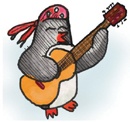Chapter 9. Games in Context

Game design is becoming a discipline. In the past 10 years there has been a large increase in the number of books about game design, the beginnings of a critical vocabulary, and the creation of academic programs. The field has started to move away from the hit-or-miss shot-in-the-dark approach, and towards an understanding of how games work.
On the facing pages, I’ve filled out a few grids with different human endeavors. This may rub you wrong philosophically. Bear with me—there are two sorts of people in this world, those who divide everyone into two sorts of people and those who don’t.
Any given activity can be performed either by yourself or with others. If you are doing it with others, you can be working either with or against each other. I call these three approaches collaborative, competitive, and solo.
Down the side of our grid, I’ve made a subtler distinction. Are you a passive consumer of this activity (to the degree the activity permits)? An audience member? If you are someone who doesn’t work on the activity, but instead lets the work of others wash over you, we’ll call you interested in the experiential side of the activity—you want the experience.
Are you actually creating the experience? Then you are engaging in a constructive activity. Maybe instead, you are taking the experience apart, to see how it works. I used to label this destructive, but ...
Get Theory of Fun for Game Design, 2nd Edition now with the O’Reilly learning platform.
O’Reilly members experience books, live events, courses curated by job role, and more from O’Reilly and nearly 200 top publishers.

